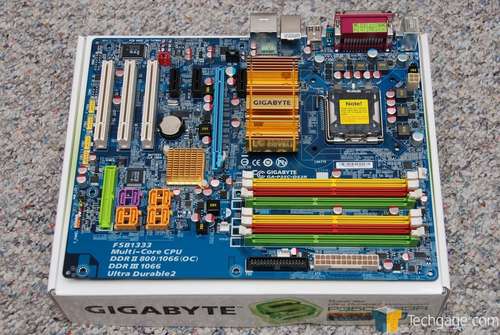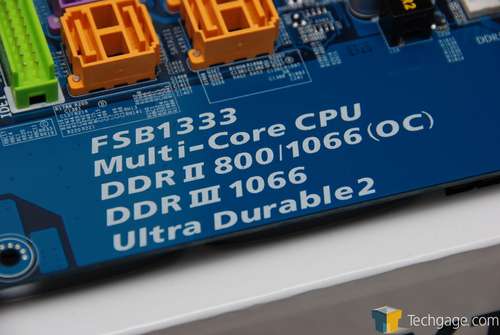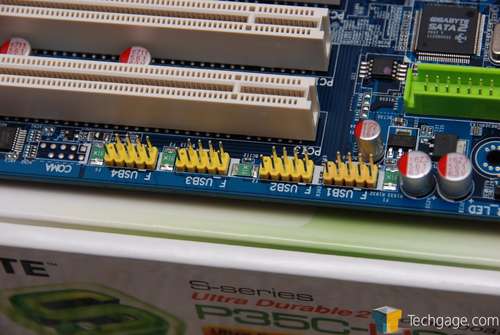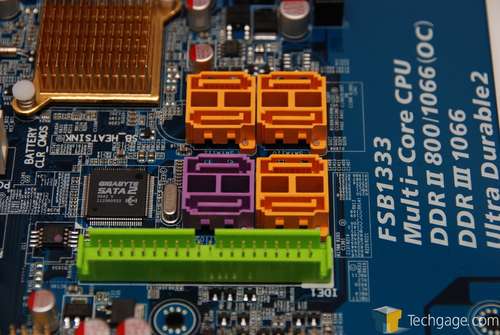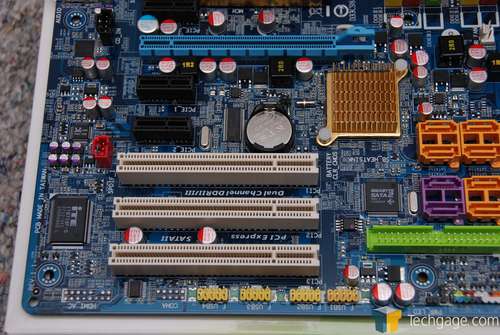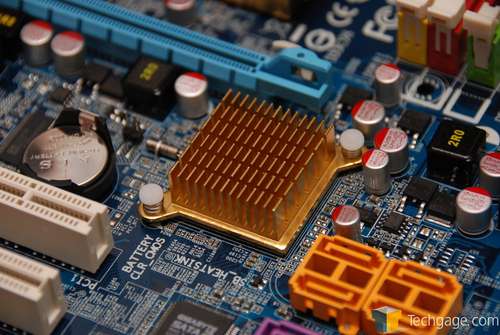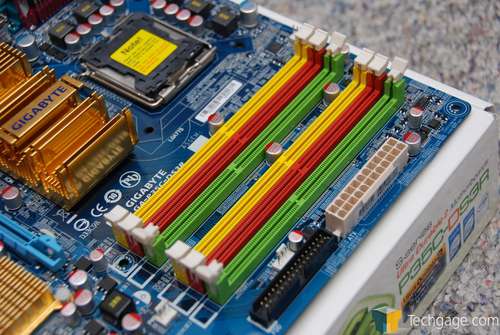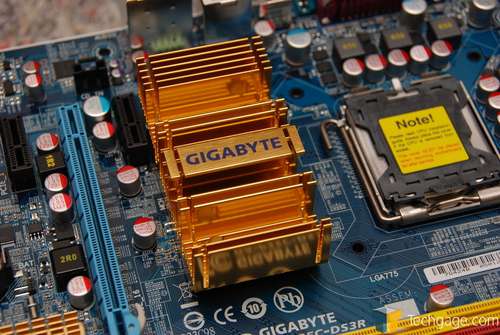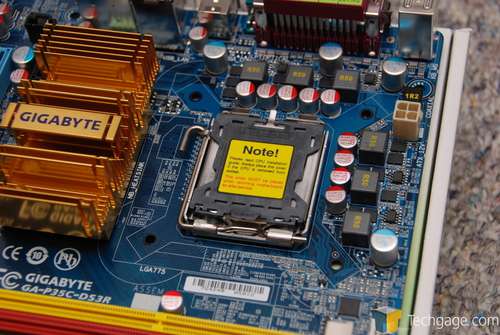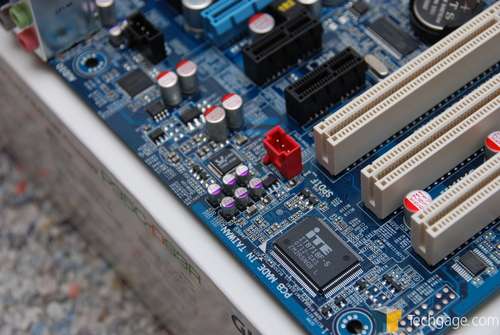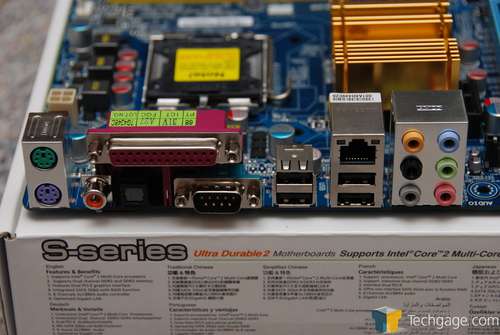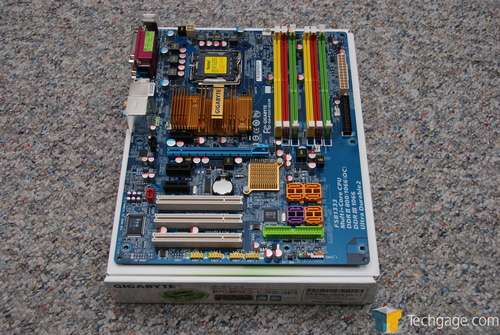- Qualcomm Launches Snapdragon 4 Gen 2 Mobile Platform
- AMD Launches Ryzen PRO 7000 Series Mobile & Desktop Platform
- Intel Launches Sleek Single-Slot Arc Pro A60 Workstation Graphics Card
- NVIDIA Announces Latest Ada Lovelace Additions: GeForce RTX 4060 Ti & RTX 4060
- Maxon Redshift With AMD Radeon GPU Rendering Support Now Available
Gigabyte GA-P35C-DS3R
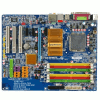
Gigabyte, like others, released a slew of motherboards utilizing Intel’s P35 chipset when it was first announced. The P35C-DS3R is unique to their line-up though, since it will accept both DDR2 and DDR3 memory. We pit the boards performance using both types of memory against our recently reviewed ASUS P5K and P5K3.
Page 2 – Closer Look
Gigabyte is well known for making some of the most colorful motherboards on the planet, and to some this is a good thing. To others, it’s foolish. Me, I have no opinion, I just care about the performance. Overall the layout looks great, no immediate complaints. Everything is located in an accessible location, except for the hard drive IDE connector port. Though I don’t have an IDE drive, I assume a hulking cable as such is going to look ugly when plugged in there.
Common of budget motherboards, the P35C-DS3R has a 4-Pin motherboard connector, instead of the usual 8-Pin. This proved an inconvenience to me, because I already had an 8-Pin routed through the back of my Antec P182 case properly. Normally this is not a problem, because you can plug an 8-Pin into a 4-Pin since both connectors have a top row of +12v and bottom row of ground. However that proved impossible here, due to a component getting in the way.
Another thing that also really inconvenienced me was the lack of 3-pin fan connectors. Besides the CPU fan connector, there are only two more, one beside the DIMM slots and the other beside the north bridge. I use a Corsair Nautilius 500 water-cooling system on the PC, and you are supposed to plug two connectors into fan ports on the motherboard. Here though, both fan connectors were out of reach, so it couldn’t be done. I am unsure why there is such a lack of connectors, though I feel it must part of the budget experience. It’s too bad though, as there is plenty of room for more.
Like here for example.
At the bottom of the board, a set of four USB connectors are clearly labelled. The P35 chipset introduced the ability for 12 USB ports off of it alone, and that’s possible right out of the box here, as long as you have that many ports available.
8 S-ATA ports are readily available at the right-side of the board, situated directly above the lone IDE connector. The board also supports RAID, if you want to take that route.
Although the P35 chipset supports Crossfire with ATI cards, it’s not supported on this board because of a lone PCI-E 16x slot. In addition to three PCI slots are three more PCI-E 1x slots. I have yet to own a single PCI-E 1x component, let alone three.
The southbridge has a modest passive heatsink, which will be enjoyed by those who like silent PC’s. During testing, I did not find this to get hot enough to warrant a fan.
Finally, the most interesting part of the motherboard. The red and yellow slots are for your DDR2, while the green are for DDR3. For DDR2 users, you will be able to use upwards of 8GB of ram, with 2GB modules. For DDR3, 8GB should be possible, but we have yet to see 2GB DDR3 modules, let alone 4GB. During installation, you have to choose between the two, neither can be used at the same time.
Compared to the south bridge, the north bridge has a massive cooler, appropriately so since the NB will get far warmer than the SB. For hardcore overclockers, a fan would be recommended.
There is sufficient space around the CPU socket for most coolers, I can’t see it being a problem to install even the largest on the market. Note the fact that the PWM doesn’t include any type of cooling whatsoever, not even a cheap passive heatsink.
The board uses the ITE IT8718F-S chipset used for I/O purposes, and though blurred, there is also a small Realtek ALC889A, used for the boards 8-channel audio.
On the back we find PS/2 ports for both Keyboard and Mouse, S/PDIF, parallel port, serial port, four USB ports, LAN port and finally, the audio jacks. Nothing is missing here per se, although on higher-end boards you would find an E-SATA and a second NIC port. As for the parallel port, the inclusion of that just confuses me, since it’s userbase would be so low. There would be a better chance of a PCI-E 1x port being used.
Here is a vertical view of the board to finish things off, since this is the way most people will be viewing it once it’s installed. Unless you turn your computer upside-down.
Before we jump into testing and performance reports, we will first take a look through the fairly robust BIOS.
|
|
Support our efforts! With ad revenue at an all-time low for written websites, we're relying more than ever on reader support to help us continue putting so much effort into this type of content. You can support us by becoming a Patron, or by using our Amazon shopping affiliate links listed through our articles. Thanks for your support!




